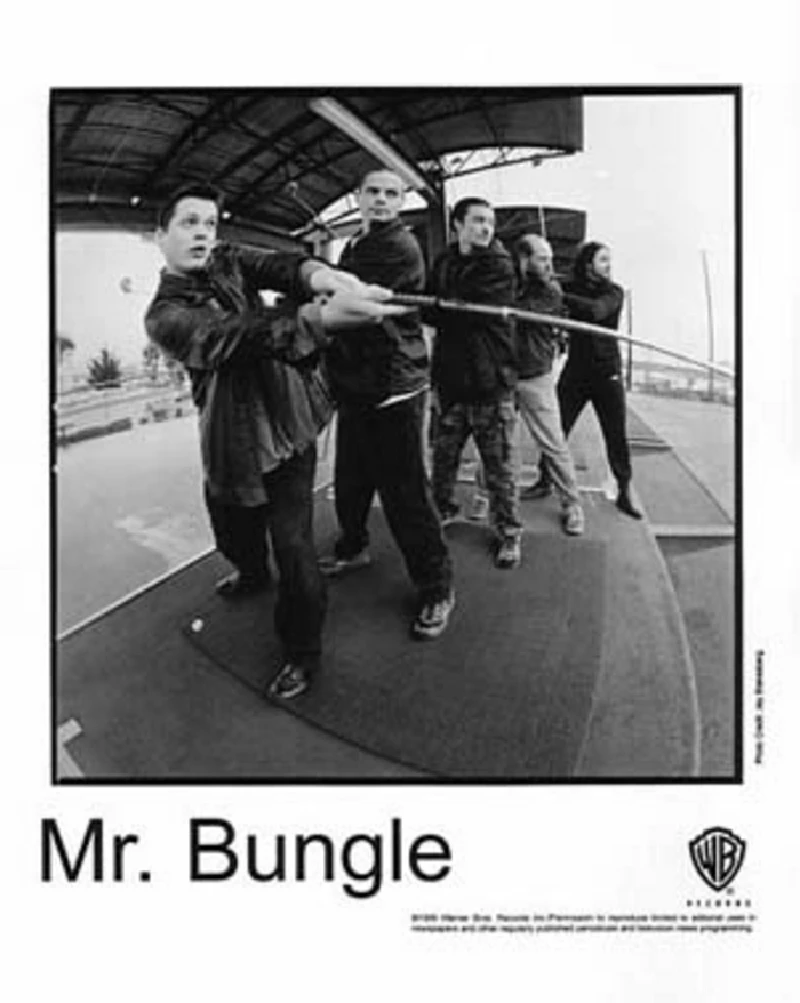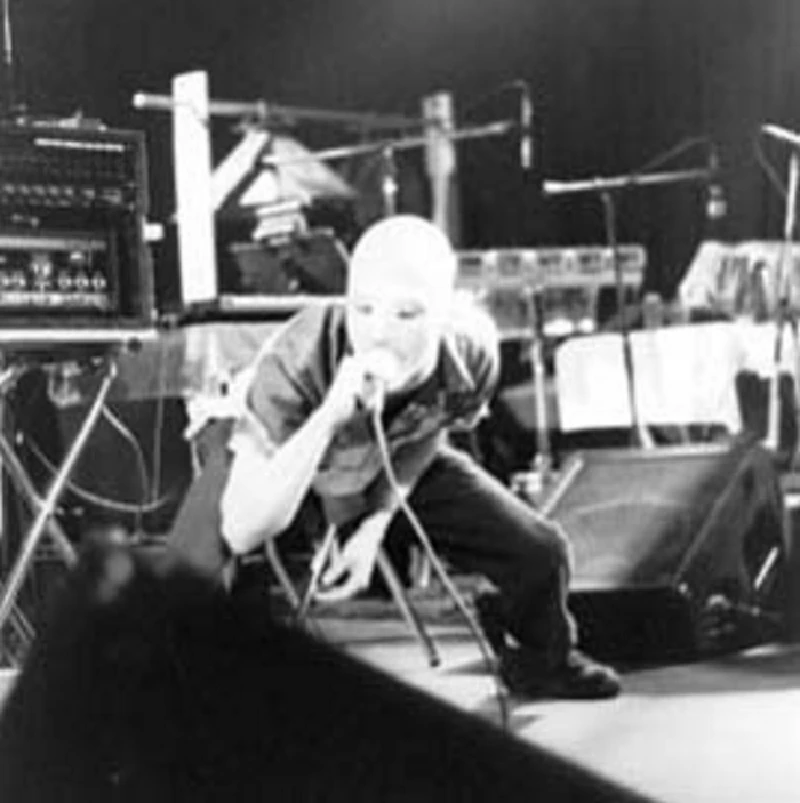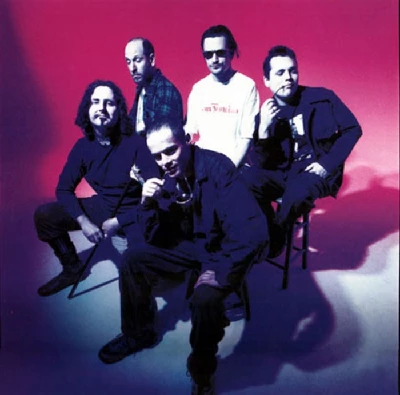Mr Bungle - Profile Part 2
by Jamie Rowland
published: 21 / 11 / 2005

intro
In the second part of his three part series about Faith No More frontman Mike Patton's other band Mr Bungle, he writes about the release of the controversial group's eponymous debut album in 1991
By late 1990, Mr Bungle had decided to sign to a major label. They decided on Warner Bros., the same label as singer Mike Patton’s other project, Faith No More, and at the beginning of 1991, they went into the studio with avant-garde composer and jazz-maestro John Zorn. When asked in one interview how Zorn came to be involved, Patton said “I approached him with the idea of working together on [Mr Bungle]. I was a fan of him before that and had some of his records and thought, well this guy could bring something to the table and we'd never made a record before, so we were infinitely insecure about what to do in a studio and how to handle it…That's basically how it started. I went to a show of his and cornered him and said ‘Listen to this, I think you might like it and I'd love for you to work with us.’ And he got right back to me and it kind of went from there and we've been close friends ever since”. Patton’s instinct was right, and Zorn’s input on the album gave the Mr Bungle sound even more depth and an added level of unpredictability, something they already had in spades. The resulting, self-titled album, released in August 1991, is a brilliant mix of metal, ska, surf, funk, rap, punk, jazz and 70's rock. The songs are fun and bouncy, but with a running theme of toilet humour (one song ends with the recording of someone noisily taking a crap), sex and domestic violence. The band mix sound samples into their music; from pinball machines, to movies, to the educational film from which they took their name. Two of the most interesting sound clips were recorded by members of the band themselves. At the end of ‘Egg’, a recording of Spruance, Dunn and Patton jumping a train can be heard. On the way back from recording this, the three friends came across a ‘skin-head’ who was apparently abusing his son. The band decided to record this too, and it features on the album after ‘Girls of Porn’, just before the powerful ‘Love is a Fist’. Opening with thirty seconds of silence, the sound of breaking glass introduces us to ‘Quote Unquote’, the album’s first song. Kicking in with a stomping, bass-heavy riff, the song suddenly changes into a freaky funk shuffle. Patton’s vocal goes up and down in pitch, seemingly overjoyed by the song's threatening sounds. From funk shuffle, to discordant organ chimes, to whispered lyrics and gentle bass licks; the song sets the tone for the rest of the album. It’s pretty clear that Mr Bungle don’t like their listeners to get too comfortable, teasing them with a catchy, bouncy piece of fun, then snatching it away and replacing it with menacing hums and computer game sounds, twisted to give them a dark edge. The result is that Mr Bungle becomes something like a musical version of a David Lynch movie; tiny snatches of familiarity, hidden under piles of weirdness, filth and sexual deviance (interestingly, David Lynch’s Blue Velvet is sampled throughout the album). One of the most accessible, and therefore popular, songs on the album is the funk-metal rap of ‘Squeeze Me Macaroni’. The song revels in its heavily sexual lyrics, and happily twists the nursery rhyme lyric "Nick nack, paddy-wack, give the dog a bone" into a perverse sing-a-long. And you do, just as happily, sing along. ‘Carousel’ is a song title which pretty well sums up the album’s sound; a kind of crazy carnival of horrors (the album artwork features a bunch of rather creepy looking clowns taken from the comic-book ‘A Cotton-Candy Autopsy’, by Dan Sweetman and Dave Louapre). The twisting, swirling, speedy-ska tune sounds like a lot of fun, but the lyrics reveal a much darker tone to the song, with Patton singing "Love and blood begin to meld, you've lost the self that you once held/Merry go round your head - awake, asleep, alive, or dead." ‘The Girls of Porn’ pretty much speaks for itself. Following a sound-clip from the porn movie ‘Mr Bungle’ (given to Patton by Faith No More bassist Bill Gould and previously unknown to the band), the song is quite simply a celebration of masturbation. Spruance spoke about the band's love of masturbation in an interview around the time of Mr Bungle’s release: "We're all really heavy masturbators. I'm the worst…Trevor can masturbate twice a day, maximum. He's lucky if he does it three times in a week. Mike and I are similar. We talk about what feels good and stuff and we're pretty similar on that. Trevor's the real oddball." An incredibly crude and juvenile but thoroughly enjoyable track, it starts with the listener being invited to ‘butt-bang their daughter’s tight, virgin cherry ass…’ before kicking in with a classic 70's rock style riff. As the verse kicks in, a sleazy brass section accompanied by Dunn’s funky slap bass makes the song sound suitably like a porno soundtrack. The last track on the album, ‘Dead Goon’, is one of the most musically accomplished. Trevor Dunn’s bass playing is astounding; he races through an incredibly complex bass-line, contrasted against Spruance’s laid-back guitar. “[That] bass-line was written by drummer Danny Heifetz (no bassist in their right mind would dream it up),” says Dunn on his own website. “It is basically two chromatic scales starting an octave apart (C#) and collapsing (one ascending, one descending) to a unison (F#). If you play this line on piano with one finger from each hand you will realize what a ridiculous concoction it is. On bass, however, it's not so easy. It took me a long time to figure out how to play it, and a very short time to forget it.” The song kind of disintegrates at the end, with the instruments seeming to drift apart from one another, as if the music is falling apart at the seams, then finally coming together for a crashing crescendo. The album closes with a mini-mix of gentle piano and violin pieces, the band seemingly poking fun at their own childishness with something that might be called a more grown-up sound. Interestingly, by the release of their second album, the band’s juvenility had well and truly disappeared. After the release of 'Mr Bungle', the band set out to promote the record, touring North America for a year. The band’s fan-base increased from town to town as they took their energetic and surprising shows. Covers including Billy Squier's 'The Stroke', 'The Star Wars Theme' and John Sebastian's 'Welcome Back' would often catch the audience off-guard. When the tour finished in 1992, the band set about working with their respective side projects; Patton with Faith No More, Heifetz with Dieselhed and Zip Code Rapists and Spruance with Faxed Head. At the same time, both Spruance and Heifetz joined Dunn in the Secret Chiefs 3. In 1995, Spruance also joined Patton on Faith No More’s phenomenal album, 'King For a Day, Fool For a Lifetime', after the band’s original guitarist, Jim Martin, was kicked out. The time spent on these side-projects meant that the band's next release was taking a long time to come together. The members of Mr Bungle were spread all over America working on different projects, so for work to go ahead on Bungle songs, parts were sent on tape around the country, with pieces being added by different members. Some copies of these demo tapes escaped into the hands of fans. The bootlegged songs included on the tape were ‘Phlegmatics’, ‘Carry Stress in the Jaw’, ‘Ma Meeshka Mow Skwoz’ and ‘Everyone I Went to High School with is Dead’. ‘Phlegmatics’ and ‘Carry Stress in the Jaw’, also known as ‘Sleep’ parts II and III respectively, follow on from ‘Slowly Going Deaf’ (or ‘Sleep (Part I)’), and complete a trilogy of songs written by Trevor Dunn which share themes dealing with bodily parts. ‘Phlegmatics’ is an aggressive, jazz/metal hybrid with ghostly vocals from Patton which creep out at you gently from behind the music. The song is eerie, to say the least. ‘Carry Stress in the Jaw’ follows suit, with jazzy tempos and random trumpet freak-outs facing off against Spruance’s speed guitar and Patton’s vocals, which dart between a soft croon and a maddened squeal. The song all but breaks down in the middle, before crawling back up with a stop-start rhythm section, before once again crashing into metal riffs and screams, then again returning to jazz. Not the easiest of listening experiences, but a compelling one, nonetheless. ‘Ma Meeshka Mow Skwoz’ sees Patton performing a kind of mutant skat; a mix of nonsense words and freaky noises, backed up by a sometimes funky, sometimes cartoon-ish music track. The song is no lighter in mood than the ‘Sleep’ songs, but is nowhere near the darkness of tone reached by ‘Everyone I Went to High School With…’, which would have trouble being upbeat with lyrics like “Another summer rolls by, and I can’t help but feel pain/All those familiar faces come back to haunt me again." The song plods solemnly along with emotionless vocals provided by all the members of the band. Every now and then the song collapses completely into a jazz-metal freak-out before slowly rolling back into its dreary plod. It’s hard to imagine quite how surprised a Mr Bungle fan of the time would have been to have heard these songs, which were the first to be released since the self-titled debut. The playfulness of the first album had completely disappeared, while the under-lying darkness had been yanked right up to the surface of the songs. But when you consider that the majority of the songs on Mr Bungle were written while the band were still at school, at least 8 years previously, it makes sense that the band’s music, along with the members, had matured. The new songs were more complex, more demanding, more exciting, and the band had only just started to touch upon their full song-writing potential.
Picture Gallery:-


features |
|
Profile Part 3 (2006) |

|
| In the final part of his series about Faith No More's vocalist Mike Patton's controversial other band Mr Bungle, Jamie Rowland writes about their last two albums, and Patton's feud with Red Hot Chilli Peppers frontman Anthony Kiedis |
| Profile Part 1 (2005) |
most viewed articles
current edition
Carl Ewens - David Bowie 1964 to 1982 On Track: Every Album, Every SongVisor Fest - Valencia, Spain, 26/9/2025...27/9/2025
Editorial - July 2025
Colin Blunstone - Thalia Hall, Chicago, 16/7/2025
John McKay - Interview
Billie Eilish - O2 Arena, London, 10/7/2025
Hothouse Flowers - Photoscapes
Bathers - Photoscapes 2
Bathers - Photoscapes 1
Cleo Laine - 1927-2025
previous editions
Heavenly - P.U.N.K. Girl EPBeautiful South - Ten Songs That Made Me Love...
Trudie Myerscough-Harris - Interview
Pixies - Ten Songs That Made Me Love...
Boomtown Rats - Ten Songs That Made Me Love....
Fall - Hex Enduction Hour
Sam Brown - Interview Part 2
Doris Brendel - Interview
Jimmy Nail - Interview
Blues and Gospel Train - Manchester, 7th May 1964
most viewed reviews
current edition
Amy Macdonald - Is This What You've Been Waiting For?Sick Man of Europe - The Sick Man of Europe
Alice Cooper - The Revenge of Alice Cooper
Phew, Erika Kobayashi,, Dieter Moebius - Radium Girls
Lucy Spraggan - Other Sides of the Moon
Blueboy - 2
Cynthia Erivo - I Forgive You
Davey Woodward - Mumbo in the Jumbo
Lapsley - I'm a Hurricane, I'm a Woman In Love
Philip Jeays - Victoria
Pennyblackmusic Regular Contributors
Adrian Janes
Amanda J. Window
Andrew Twambley
Anthony Dhanendran
Benjamin Howarth
Cila Warncke
Daniel Cressey
Darren Aston
Dastardly
Dave Goodwin
Denzil Watson
Dominic B. Simpson
Eoghan Lyng
Fiona Hutchings
Harry Sherriff
Helen Tipping
Jamie Rowland
John Clarkson
Julie Cruickshank
Kimberly Bright
Lisa Torem
Maarten Schiethart